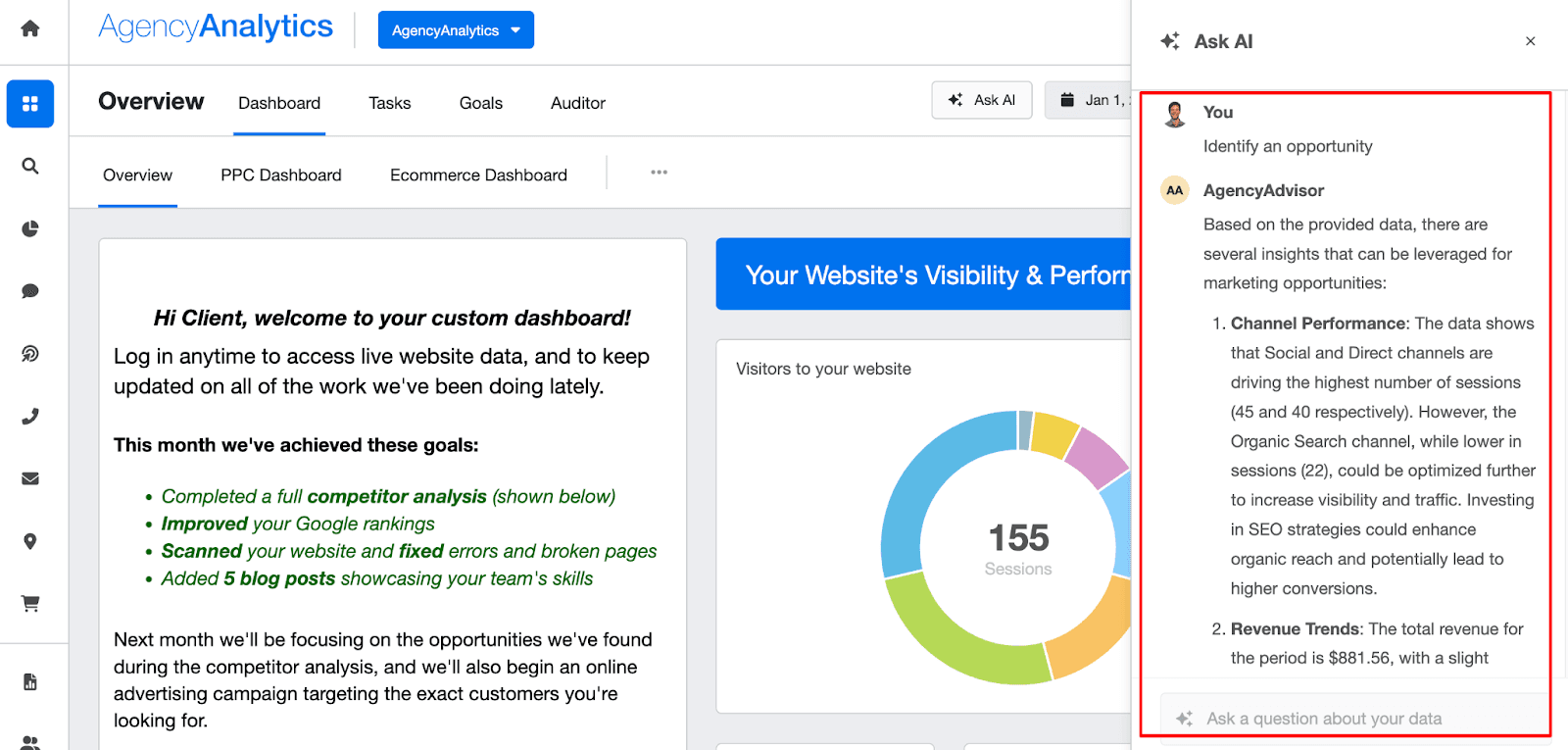Table of Contents
QUICK SUMMARY:
In this article, Puneet Mulchandani, VP of Product at AgencyAnalytics, discusses how to recognize the early signs that your agency is about to hit a business growth plateau, along with 5 strategies to help you overcome this stagnant period and reignite momentum.
As much as we'd like the rapid growth phase to last indefinitely, most agencies will eventually hit a business plateau where growth stalls.
A plateau is one of the trickiest stages for a business owner or leadership team to navigate. But with proactive planning and the right attitude, hitting a period of business stagnation can become an opportunity to evolve your business strategy and prepare for the next growth phase.
Recently, I gave a presentation at our AgencyAnalytics team meetup in Toronto. In it, I detailed our company’s plan to identify future growth plateaus, address them, and push through them to maintain an upward trajectory.
Though the details differ slightly between the business models of a SaaS company like ours and our marketing agency clients, the overall principles share a great deal in common.
In this article, I’ll share how to recognize the signs you’re about to hit a period of business stagnation, the most common mistakes to avoid when navigating this stage, and best practices for successfully overcoming it.
3 Signs a Business Growth Plateau Is on the Horizon
The key to surviving a growth plateau–and thriving afterwards–is to plan ahead. Anticipating a plateau enables your team to prepare and strategize, making a slowdown more likely than a complete stall on growth.
Here are some telltale signs that indicate you might have a plateau looming ahead at your agency, plus what key business metrics you should be looking at for confirmation:
Slower Revenue Growth
Flattened or declining revenue growth is one of the most apparent indicators of a plateau. Despite ongoing client acquisition and retention efforts, revenue growth and cash flow may stagnate, signaling that it's time to explore new markets or approaches.
Client Acquisition Challenges
Leading up to a business plateau, you’ll notice that it gets harder and harder to acquire new clients. If your Customer Acquisition Cost starts to rise, it’s a surefire way to tell that something is off. Another sign is realizing that you’ve already got most of your ideal prospects as clients.
Increased Competitive Pressures
Agencies grow quite quickly in the beginning once they’ve nailed their service-market fit. But soon enough, competitors catch up, copycats emerge, and the market feels increasingly saturated—another key sign you’re nearing a plateau.
The good news is that even if these indicators are present, there’s no cause for alarm. Your success at moving through this phase comes down to your pulse on the market—how well you understand what’s going on with your clients, the industry, and other players in the space.
What Are The Main Causes of Business Growth Plateaus?
Now, let’s distinguish between when a plateau results from a market-driven challenge or from challenges with internal operations.
External Factor: Market Saturation
Usually, when we talk about business plateaus, they’re driven by external factors like market saturation. In this case, you’ve simply capped how many clients your agency services solve problems for.
For example, consider the typical product lifecycle: After launching, you aim to achieve product-market fit, testing your agency services with clients to gauge demand. When demand begins to outpace your ability to keep up, you’ve entered a high-growth phase. Eventually, as a greater number of agencies offer similar services, the market saturates, and your growth slows, leading to a natural plateau.
AGENCY TIP
Anticipate market challenges by using competitive insights. For instance, SaaS companies like AgencyAnalytics use the Rule of 40 to assess and maintain the health of growth rate and profit margin numbers. Similarly, agencies should consider keeping an eye on key factors like delivery margin–the ratio of delivery cost to agency gross income.
Internal Factor: Operational Issues
Are all plateaus natural business curves, or are there cases where plateaus result from operational issues? If customer demand is strongly present but you’re having trouble keeping up, it’s likely an internal issue.
Business metrics like Churn Rate and NPS score help you identify if your agency is facing internal challenges or missing the mark on what clients want. An increasing churn rate could mean your business model or service isn’t meeting client expectations. A decrease in NPS means your clients are less satisfied with your offering as you bring on more accounts. Track these metrics regularly to allow yourself time to make internal adjustments before it’s too late.
In digital marketing, it feels like there's never enough time in the day to get everything you want done. But when we had to start saying no to clients we'd love to work with because we had no capacity, that's when we realized something had to change.
Michelle van Blerck, Communications Manager, Digital Freak
The Biggest Mistakes Agencies Make When Nearing a Plateau
The period surrounding a business plateau is fraught with anxiety for agency leaders. Concern about the agency's future growth causes even the most steadfast business owners to panic and react out of fear rather than take strategic action. Let’s look at some of the most common mistakes agencies make when growth starts to stagnate and what to do instead.
Not Planning Soon Enough
It’s best to think ahead before reaching a plateau; once you’re there, critical growth decisions become much harder to make under pressure. It’s easier to consider new approaches in the good times when revenue is growing, and you have all the right resources at your disposal. Planning is significantly more difficult when times are tough and you’re pressed for both hours and budget.
While it's challenging to carve out time when you’re busy keeping up with client demand and maintaining a consistent client experience, intentionally setting aside time to think ahead makes all the difference. Investing in planning helps you clarify your options for moving forward, validate your ideas, and collect data to build your confidence.
Abandoning The Core Offering
It’s common for agency owners to focus heavily on expanding their services or breaking into new market segments. They invest most of their resources there and end up neglecting their core business model and existing customer base. When growth eventually slows, they scramble to pivot. By then, critical planning is already overdue. Keeping your core offering strong and consistent is essential to support new growth rather than stretching resources too thin.
Overcommitting to Ideas Without Sufficient Validation
Another common mistake is going all-in on one expansion idea without enough data or validation to back it up. While moving quickly on an idea is tempting, if it doesn't work out, it will set you back even further.
Remember how hard it was to get your first service off the ground? Without a backup plan or multiple options to consider, you risk losing your footing if the new direction doesn’t pan out. Validation can be as simple as talking to your clients or gathering enough insight to feel confident that your new idea meets a real need.
While diversifying efforts is important, putting all your resources into one idea is problematic. Find the right balance—keep multiple growth initiatives moving forward without overextending yourself. Focus on a manageable number of priorities to ensure steady progress without overwhelming your team.
5 Strategies for Pushing Through a Business Growth Plateau
As your agency matures, growth plateaus are inevitable, but they don’t have to be permanent. Here are five key strategies to help you break through an agency business growth plateau, regain momentum, and keep your agency on an upward trajectory.
1. Carve Out Dedicated Time To Assess Your Business Strategy
To avoid getting backed into a corner, carve out regular time to assess your business model and marketing strategy. Use this dedicated time to review your key business metrics like cost of acquisition, lifetime value, and operating expenses, then consider how you might adjust your marketing efforts in response. Gaining this clarity will allow you to forge new paths and avoid ending up in a reactive scramble.
2. Balance Short and Long-Term Goals
Balancing short-term wins with long-term growth is essential to prevent stagnation and ensure sustainable success. Your first priority should be meeting current revenue targets, which often requires short-term adjustments to sales and marketing strategies.
If immediate goals aren’t met, it might be necessary to double down on activities that drive quick results, such as upselling existing clients, considering new marketing channels, or improving your client experience to maximize retention. This focus allows your agency to make immediate gains that stabilize the business, providing a solid foundation to explore future growth avenues.
Once short-term objectives are on track, it’s easier to dedicate more resources to long-term planning. An example would be applying the 80/20 rule—where you spend 80% of your time on current needs and 20% on future strategy to maintain balance.
3. Validate Potential Directions With Your Customers
Our best advice for getting a strong pulse on the market is to talk to your clients frequently. Many business owners make the mistake of pulling back on customer conversations once they feel confident in their offering. But remember that the market is constantly evolving! Don't stop those conversations even if you have a solid offering and feel like you know the space. Simply adjust the questions you ask.
Ask clients how they feel about your agency services, your competitors, and the potential directions you could take. This will give you early insight into emerging client needs and market shifts. Test the waters with clients to see if they’d be interested in a new service offering. Ask them how they’re currently solving their needs and explore how you might address those needs more effectively. All of this is a great way to get direct validation on whether or not you’re on the right track.
For example, at seoplus+, they test new services with clients by first offering them the service for free. They’re picky about the clients they choose for these pilot projects (finding the right fit is key, and trust plays a big role here), but this method enables their agency to gain immediate, real-world feedback on new offerings right from the source itself.
Talking to your customers is as simple or rigorous as you want it to be. If you’re a large organization, you might choose to do surveys and studies to validate decisions at scale. But for most agencies, simple one-on-one conversations give enough insight and qualitative anecdotal feedback to start validating potential directions.
Talk to your customers. Get their feedback. And listen. It puts a fresh pair of eyes on your offering from the most important perspective - your audience.
Michelle van Blerck, Communications Manager, Digital Freak
4. Create Team Alignment on Your Marketing Strategy
Once you have enough validation to confidently choose a path forward, share your plan with your agency management team and employees. You don’t need a flawless strategy or every detail finalized, but aligning everyone around a common goal is powerful. This shared sense of purpose boosts morale, energizes your team, and ensures everyone is pushing in the same direction. When teams work together with clear objectives, it creates momentum that drives progress and helps the business achieve its goals faster, effectively moving you out of the plateau and into the next growth phase.
This was my intention in creating and giving my presentation at our recent company meetup–to ensure that the entire AgencyAnalytics team was aligned on the vision for our company’s future moves.
5. Turn To Other Agencies for Inspiration
Uncertainty usually creates panic. Remember that many entrepreneurs in the agency world have gone through plateaus and remained successful. Turning to other agencies that have undergone the same process and have worked through slow periods will only inspire you to push through your plateaus with grace.
How AgencyAnalytics Is Pushing Past Growth Plateaus
At AgencyAnalytics, we’re planning proactively for our next growth stage by staying true to our mission and focusing on product expansion. This approach means examining how we serve our customers’ evolving needs with tools that empower their growth.
Historically, we’ve streamlined time-consuming reporting tasks through automated reports; now, we’re broadening our offerings to address additional core challenges agencies face.
A major growth area for us is helping agencies dive deeper into their data. Recognizing that many lack the time or resources for in-depth analysis, we’re investing in features that surface AI-powered insights, proactively detect anomalies, and provide industry benchmarks–fast. Recent releases like Ask AI and AI Summary exemplify how we’re turning raw data into actionable insights that drive client success in a fraction of the time.

Save time on data preparation and quickly surface insights that impress your clients. Try AgencyAnalytics free for 14 days.
By consistently reassessing market needs and aligning our capabilities with our vision, AgencyAnalytics is positioning itself as the platform of choice for marketing agencies. Expect more exciting updates in 2025 as we continue our journey to redefine agency success.
The Takeaway
Stagnating growth is a natural part of the business cycle. The beauty of growth plateaus is that they’re so predictable. Knowing that they’re absolutely going to happen and that you’ll see them repeatedly means you’ll have no choice but to tackle them head-on! The key is to anticipate your plateaus, actively validate new ideas, and keep your options open.
Don’t wait until growth stalls completely to start your planning–stay proactive, keep an eye on market trends, and remember that with a clear strategy, a plateau is another stepping stone to your agency’s success.

Written by
Puneet Mulchandani is an engineer-turned-product leader who loves solving meaningful problems. Over the past 15 years, he's built and scaled up product teams, worked across a variety of industries, and co-founded a tech startup. He's currently the VP of Product at Agency Analytics where he leads Product Management, Design, and Product Marketing.
See how 7,000+ marketing agencies help clients win
Free 14-day trial. No credit card required.






